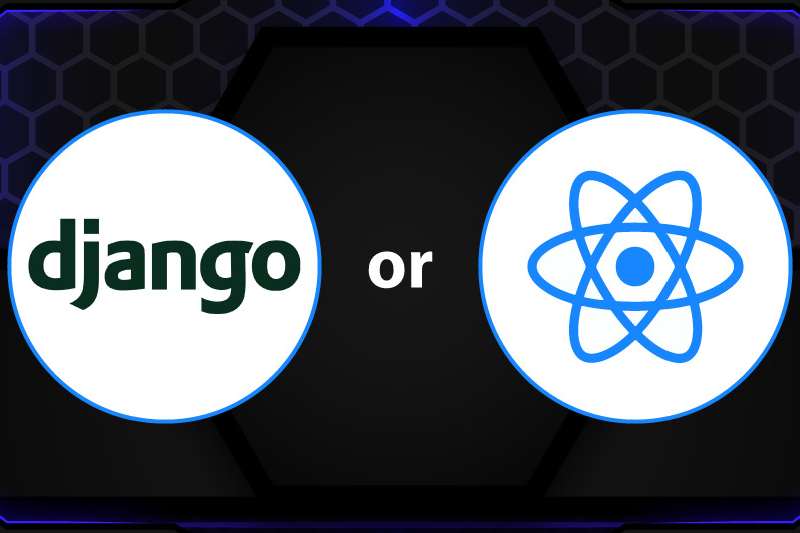
Django vs React–How Do They Differ? (Pros and Cons). In this article, we first explain both technologies before outlining their main distinctions. Because devices and browsers have changed over time and the software that operates them. Some of the most well-liked software frameworks have been created recently to support the daily websites we use. React JS and Django are two of the most well-known frameworks, but which one is best for you?
To help you choose your chosen web development framework, we’ve put up an in-depth comparison of Django and React. Continue reading to find out more about each framework’s capabilities, potential applications, performance and scalability comparisons, and suitability for different kinds of websites. You will have all the knowledge necessary to choose the ideal framework for your upcoming web development project once you have finished reading this article.
What is Django?
Django is a powerful, python-based web framework known for its high-level features and ease of use in developing web applications and APIs. Furthermore, developers can streamline the process by utilizing these modules. Since they don’t have to start from scratch, developers may construct apps and websites using Django’s modules directly from pre-existing sources, greatly speeding up the development process.
Django is unable to use several functions, such as file uploading, authentication support, commenting, contact forms, managing apps, etc.
Django Backend Development Techniques
Django supports quick development and simple, practical design, so developers can concentrate on developing their applications instead of trying to create them from scratch.
Django’s Representational State Transfer (REST) architecture, which enables the creation of unique APIs, is utilized while creating backend web applications. One of the significant advantages of REST APIs is the high level of flexibility they provide. Because of this, the Django REST framework effectively serves as a flexible, scalable, and potent web API development environment.
Additionally, the framework is very scalable, allowing developers to create smaller projects before moving on to more intricate applications that require a lot of user traffic and data.
Industry titans typically use the technology to create a variety of platforms. It consists of data processing platforms, content management systems, and social networks. The busiest websites, like Netflix, Spotify, Instagram, YouTube, Dropbox, and Pinterest, leverage Django’s rapid scaling and adaptability to handle high-traffic volumes.
What Is React?
An interface-building library for JavaScript is called ReactJS. Facebook employees built it, and the corporation is still working on it. Although it may be used to build single-page applications (SPA), it is best suited for building web pages. ReactJS has a sizable development community and is quick and reliable.
It is utilized by a variety of well-known businesses, such as Netflix, Airbnb, and Imgur. For creating user interfaces, ReactJS is an adaptable declarative, and effective, JavaScript library. Your code will be simpler to comprehend and maintain if you can design reusable components. ReactJS may be used to create complicated web apps when paired with a backend framework like Django.
React JS Frontend Development Techniques
There are two basic choices when utilizing a JavaScript framework. A client-side rendering, where the user interface is rendered by the browser after downloading the necessary code, or a server-side rendering, where the user interface is created on the server. Single-page application use React.js to load and refresh a single HTML page dynamically based on user input.
ReactJS enables developers to build reusable, standalone components that produce high-performing applications. Virtual DOM (Document Object Model), a special function that frees developers from constantly updating the View, enables them to create server-side rendering (SSR).
React vs. Django: Key Differences
Since creating scalable and stable online apps requires the usage of both React and Python Django, two well-liked web frameworks, A common method of web development is to use React.js as the frontend framework and Django as the backend framework.
Here are a few distinctions between Django and React that can help you make your decision.
Django vs. React: Framework
Django is an open-source, versatile web framework with several improved features. It is compatible with the strategy that includes batteries. For huge projects and complicated websites, this web framework is fantastic.
In contrast, Reactjs is a lightweight, quick, and flexible framework that allows a component-based design approach. For straightforward and modest tasks, the Python web framework excels.
React vs. Django: Working Style
In the same way, Django adheres to an object-oriented philosophy while supporting underlying technologies, templates, tools, and plugins. It also allows a monolithic working style and object-relational mapping. works well for apps with several pages and a complicated design.
React, on the other hand, builds applications’ display layers using simply plain JavaScript and a component-based methodology. Ideal for straightforward projects that aid in controlling component instances.
React vs. Django: Database Support
Furthermore, relational database management systems like MySQL, Oracle, and others are compatible with the Django framework.
Realm, PouchDB, SQLite, Async Storage, and other databases are used by React for executing activities.
Django vs React – Flexibility
Fourthly, the Django framework is flexible and can operate on different platforms. However, it is challenging to make modifications to the module. It is tough to understand as compared to other frameworks.
The JavaScript library is flexible and employs reliable development tools that streamline the process of application development. Clearly, it is simple to understand and operate.
React vs. Django: Control
Due to the built-in libraries, the Django framework does not provide complete control over the functions. It doesn’t provide API assistance.
React gives more control over the JSX conditional statements and application development process. API integration is possible.
Community Support for Django vs. React
In addition, the Django framework provides thorough documentation and a robust support network. A few businesses that trust Django include Instagram, Udemy, and Coursera.
Similar to how React has a large support network but no documentation. A few businesses that trust React include Airbnb, Netflix, Yahoo, and Dropbox.
We appreciate your interest in Django vs. React: What’s the Difference (Pros and Cons). We’ll now wrap up this article.
What Differs Between Django and React? (Pros and Cons)
In conclusion, Django and ReactJs are two open-source web frameworks that are used to create online applications using Python and JavaScript, respectively. They both offer good capabilities. Website building framework Django and JavaScript library React.js are both used.
Last but not least, React is an open-source library that constructs user interfaces or UI components. We sometimes refer it to as React.js or ReactJS. For flawless react js services, you may hire react js developer.
While Django is a high-level Python web framework that allows developers to leverage modules to accelerate development. Django is a high-level Python web framework with many built-in capabilities that make it easy to create complex online applications rapidly.
